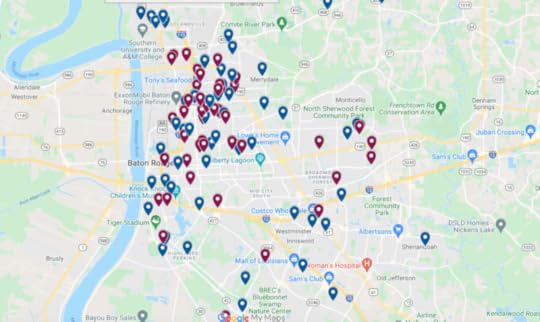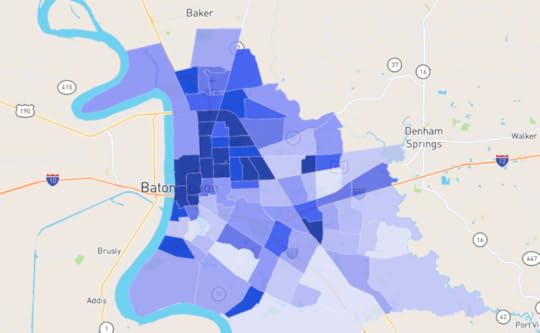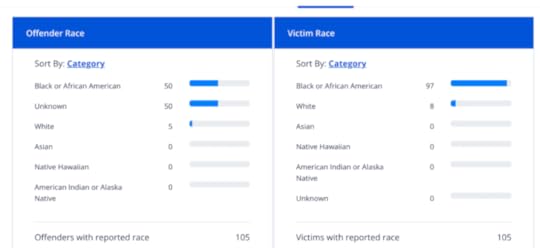Woke Crime Data Blackout
News from the City of Brotherly Love:
Oh look, my congressional representative was carjacked at gunpoint in Philadelphia today.
Just another day in an American city in 2021. https://t.co/Oa58EUFTdt
— Damon Linker (@DamonLinker) December 22, 2021
The story reports:
As of December 6, Philadelphia had recorded 521 homicides for the year, surpassing New York’s 443 and Los Angeles at 352.
This is despite the fact that with a population of 1.5 million, Philly is less than half the size of Los Angeles and one-fifth of New York.
Remember that Philly is blessed to be one of those large American cities with a George Soros DA.
I’ve looked around at several versions of the robbed Congresswoman story, and one thing I can’t find is a physical description of the suspects. I assume in these cases that the suspects are black, and the media are deliberately hiding this fact. I was working in newspapers in the first decade of this century, when there was a push in the industry to stop identifying the race of crime suspects. At least some of the Dallas media embraced it. I remember sitting at my desk when it was reported that there was an armed robbery suspect loose in the Knox-Henderson neighborhood uptown. You would think that it would be of utmost importance to let the public know as much as it could about the physical description of a robber running around with a gun. But not the Dallas media, at least not most of it that afternoon. I finally found a TV station’s report about the situation, and it was the only one that mentioned the race of the suspect: black.
Back then, it was more important to local news editors and producers to keep white people from making negative judgments about black crime suspects than it was to protect them from an armed robber on the loose. I don’t imagine their news judgment has gotten any better, certainly not since the George Floyd killing.
My city, Baton Rouge, is having a record-setting year for homicides. I haven’t seen a detailed breakdown by demographics for 2021, but if it’s like every other year, the killings are almost entirely black-on-black murder, especially involving young black men. We aren’t hearing much about it from local Black Lives Matter enthusiasts, no doubt because black lives only really matter to them when they are taken by police officers. Shondreka James, the mother of one of those homicide victims, expresses the hopelessness of the moment here:
“Things are completely out of hand. No human, no law enforcement, no judge can actually stop this today,” she said.
The violence used to be confined to all-black neighborhoods, but now it is increasingly spilling over into majority white areas that used to be safe. Siegen Lane is in south Baton Rouge, on the opposite side of the city as the majority-black communities, but every couple of weeks there’s a report of gun violence there. One of my mom’s neighbors and her daughter were caught on a Siegen Lane shootout a few weeks back between two cars full of armed young black men.
My subdivision is racially mixed but majority white. Yet we have a property crime problem. If you follow the Next Door list, and watch people’s security camera videos, on those where you can tell the race and sex of the thief, they are invariably black males.
As a society, we never, ever talk about this stuff in public. Our newspapers and TV stations don’t report on it. Nobody runs op-eds about it, because this discourse is not permissible, any more than it is possible in our media to discuss anything to do with LGBT people or Muslims in a negative light. The taboos are very strong, especially in the age of cancel culture.
Now comes news that two major real estate brokerages are scrubbing information about crime rates from their home listings — this, to promote “equity”:
Realtor.com has removed crime data from its website, and Redfin has decided not to add it out of concerns that it could perpetuate racial inequity.
David Doctorow, the CEO of Realtor.com, said in a company update this week that the crime map layer has been removed from all search results on the website “to rethink the safety information we share on Realtor.com and how we can best integrate it as part of a consumer’s home search experience.”
Doctorow said the removal was part of a company effort to “level the playing field” and scrutinize what safety means to buyers and renters so that it can “reimagine how we integrate safety data” on the platform. Realtor.com has been collaborating with fair housing advocates as part of the initiative.
“Reimagine how we integrate safety data” is Orwellian phraseology for “figure out how to bury crime stats to hide the demographic characteristics. More:
“At this time of complexity in real estate, our team has been energized by our purpose to simplify real estate choices, especially for first-time homebuyers,” he wrote. “Yet we keep bumping up against one very old and persistent problem: the ability to afford and own a home can be unjustly limited by one’s race, ethnicity, or other personal characteristics.”
Well, okay, but what does home showings and mortgage offerings have to do with crime rates? Nothing, in fact. Why won’t you tell us how safe the neighborhood is?
Because, according to Redfin, crime data do not tell us anything about the safety of a neighborhood. Seriously, this is what Redfin claims — that you cannot trust data. More:
On the same day that Realtor.com announced that it was removing its crime data, Redfin came out with a full-throated denunciation of crime data being included on real estate websites. Redfin’s chief growth officer Christian Taubman announced that, after consideration, the company would not be adding crime data to its own platform.
Taubman said that Redfin had been weighing whether to add information about crime because one of the metrics that consumers consider when looking for a home to purchase is how safe the area around that home is. The company concluded that available crime data doesn’t accurately answer that question, and “given the long history of redlining and racist housing covenants in the United States there’s too great a risk of this inaccuracy reinforcing racial bias.”
Redfin highlighted the difference between crime and safety and said that through its research, which included surveys, people defined safety in a variety of ways. Taubman said that the available data, namely the Uniform Crime Report from the FBI, pertains to reported crimes and excludes information about crimes that go unreported and crimes that go unsolved. He said that data at a neighborhood level could lead to high inaccuracy.
“The fact that most crimes are missing creates a real possibility that the crimes that show up in the data set skew one way or another,” Taubman wrote. “And the fact that most reported crimes go unsolved means that some of the crimes being reported in fact may not be crimes.”
This is total horsesh*t, of course. Taubman and his woke capitalist colleagues don’t want to report crime rates because they don’t want home buyers of any race putting distance between themselves and predominantly black neighborhoods, because that’s where most of the crime is. They would rather see people buy houses that put themselves and their families in danger of crime than be thought of as perpetuating racial stereotypes about who commits most violent crime — demographic stereotypes that are almost always true. It’s like the Dallas media back in the day: they think the real danger to the common good is not from a black armed robber running around uptown, but from white people making a racial judgment about black men and crime.
The thing is, any home buyer with a lick of sense is going to check out the crime stats in neighborhoods where he is looking to purchase. You’d be a fool not to. Here is the 2020 homicide map for Baton Rouge. If you know the city, you can tell that the majority of these killings happened in predominantly black parts of town:

Here is a graphic from Neighborhood Scout, showing where the most crime-ridden neighborhoods are. Again, it’s easy to see that these are the predominantly black parts of our majority-black city:

The Baton Rouge Police Department releases annual crime stats, but keeps demographic data out of it. But they do share that data with the FBI. Want to know how the homicide stats broke down demographically in my city in 2020? Look at this FBI graphic:

If you look further, you will see that the overwhelming majority of victims and offenders are males, with young people disproportionately represented. If you are going to be murdered in Baton Rouge, you are overwhelmingly likely to be black, and so is your killer (nobody can seriously think that the fifty murderers of unknown race are anything other than disproportionately black).
Look, I understand why this is a painful subject to talk about. But the idea that woke capitalists in the real estate business would rather sell people houses in riskier neighborhoods for crime rather than give them data and let the customer decide what to do with that knowledge infuriates me. In 2005, when we bought our first house, in Dallas, we didn’t have a lot of money, and ended up choosing a house in a mixed-race gentrifying neighborhood. It was what we could afford, and besides, we looked at the crime stats, and though violent crime was a lot closer to our street than we would have liked, we concluded that the risks and the rewards made it worthwhile. No agent back then felt it necessary to hide relevant crime data from us to prevent us from making a decision they might regard as racist.
How long are we all going to have to live by these lies that the overclass imposes on us? Why are we not allowed to talk about these things? Do these patronizing wokesters think that black families are pleased to live in crime-infested neighborhoods? My neighborhood is a plain-jane middle class subdivision, and I am quite sure that the black families who live in this neighborhood were happy to move to one where the streets are safer, even if most people who live here are white. The desire for a safe place to raise one’s children is not limited to people of any race. As a parent, I want to live in the safest place I can afford. Doesn’t everybody with kids want the same thing? In a city, that is my No. 1 priority when considering buying a home. Why should these do-gooder real estate agents withhold basic information like that from ordinary people of whatever race? Why do they get virtue points from hiding ideologically inconvenient truths from the public?
Let me poll the room: does anybody here think that real estate agencies, media outlets, and other gatekeepers withholding this kind of data from consumers makes us a less racist society? Or does it make us more suspicious, because we assume that relevant information is being withheld from us for political reasons?
The post Woke Crime Data Blackout appeared first on The American Conservative.
Rod Dreher's Blog
- Rod Dreher's profile
- 503 followers



